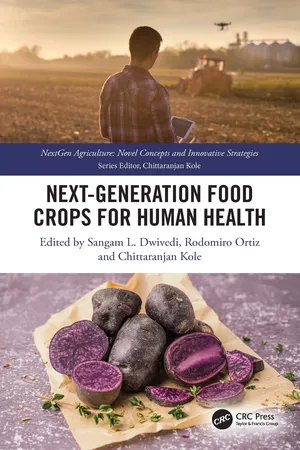
Next Generation Food Crops for Human Health
- English
- ePUB (mobile friendly)
- Available on iOS & Android
Next Generation Food Crops for Human Health
About this book
As the global population surges, the challenge of feeding the world becomes increasingly urgent. Meeting this demand requires doubling crop yields and delivering safe, nutritious, and affordable food, but current agricultural practices fall short in combating malnutrition, climate change impacts, and the decline in food diversity.
Next-Generation Food Crops for Human Health delves into the advances in genetic and genomic research that are revolutionizing the development of productive, nutrient-dense food crops. It presents insights into tools including high-throughput phenomics, DNA sequencing, and genomic selection, which enable scientists to discover functionally characterized genes and enhance staple crops, such as grains, legumes, fruits, vegetables, and oil crops. By leveraging these technologies, researchers are creating a new generation of foods that optimize essential nutrients, from complex carbohydrates and proteins to vitamins and bioactive compounds.
A volume in the Nextgen Agriculture: Novel Concepts and Innovative Strategies series, this book is valuable to graduate and postgraduate students, postdoctoral researchers, and policymakers working toward improving nutritional security worldwide.
Frequently asked questions
- Essential is ideal for learners and professionals who enjoy exploring a wide range of subjects. Access the Essential Library with 800,000+ trusted titles and best-sellers across business, personal growth, and the humanities. Includes unlimited reading time and Standard Read Aloud voice.
- Complete: Perfect for advanced learners and researchers needing full, unrestricted access. Unlock 1.4M+ books across hundreds of subjects, including academic and specialized titles. The Complete Plan also includes advanced features like Premium Read Aloud and Research Assistant.
Please note we cannot support devices running on iOS 13 and Android 7 or earlier. Learn more about using the app.
Information
Table of contents
- Cover
- Half Title
- Series
- Title
- Copyright
- Dedication
- Preface to the Series
- Acknowledgement
- Contents
- Preface
- About the Editors
- Contributors
- Introduction
- Abbreviations
- Glossary
- Chapter 1 Importance of Health and Nutrition Security: Origin and Evolution of the Concept
- Chapter 2 The Green Revolution Impact on Nutritional Quality and Malnutrition in the Global South
- Chapter 3 Genotype (G), Environment (E), G × E Interaction (GEI), and G × Management (M) Interaction (GMI) Effects Influencing Nutritional, Sensory, and Textural Traits
- Chapter 4 Combining Lexicons (Breeders’ Sensory Test by Trained Human Panel), Volatile Compounds, and Physicochemical Attributes for Sensory Evaluations
- Chapter 5 Cataloguing and Factoring Chefs’ and Consumers’ Preferences as a Guide for Developing New Cultivars with Unique Nutritional and Health-Promoting Characteristics
- Chapter 6 Crop Wild Relatives, Landraces, and Heirloom Germplasm: The Source of Novelty for Taste and Flavor
- Chapter 7 Allelic Variation Associated with Culinary, Sensory, and Textural Traits in Cereals and Food Legumes
- Chapter 8 Exploiting Natural and CRISPR/Cas9-Induced Allelic Variations in Betaine Aldehyde Dehydrogenase (BADH) to Develop Fragrant Grains, Fruits, and Vegetables
- Chapter 9 Biofortification: Transforming Staple Food Crops for Enhanced Aroma, Flavonoids, and Micronutrients with Reduced Seed Phytate
- Chapter 10 Minimizing the Risk of Toxins in Staple Food Crops via Crossbreeding and Biotechnological Interventions
- Chapter 11 Progress in Development of High-Oleic and/or Hypoallergenic Peanuts with Sensory and Textural Traits
- Chapter 12 Reducing Bitterness in Cucurbitaceae and Glucosinolates in Brassicaceae
- Chapter 13 Profiling Germplasm and Identifying Genes and Markers Associated with Horticultural and Sensory Traits, and Developing Improved Germplasm of Cucurbitaceae
- Chapter 14 Genetic and Molecular Basis of Horticultural and Sensory Traits in Melon Species
- Chapter 15 Genetics, Genomics, and Breeding of Health-Relative Bioactive Compounds in Bitter Melons
- Chapter 16 Profiling Heirloom Tomato Germplasm: Metabolites, Textural Traits, and Consumer Preferences
- Chapter 17 Genetic and Chemical Toolbox for Developing Tastier Tomato Germplasm and Reinstating Flavor to Commercially Grown Tomatoes
- Chapter 18 Profiling Brassica leafy Germplasm for Glucosinolates and Their Compounds
- Chapter 19 Molecular Insights Regulating Glucosinolate Metabolites Among Brassicaceae Germplasm: A Comprehensive Analysis
- Chapter 20 CRISPR/Cas-Mediated Genome-Editing to Develop Flavonoids Enriched Fruits and Vegetables
- Index